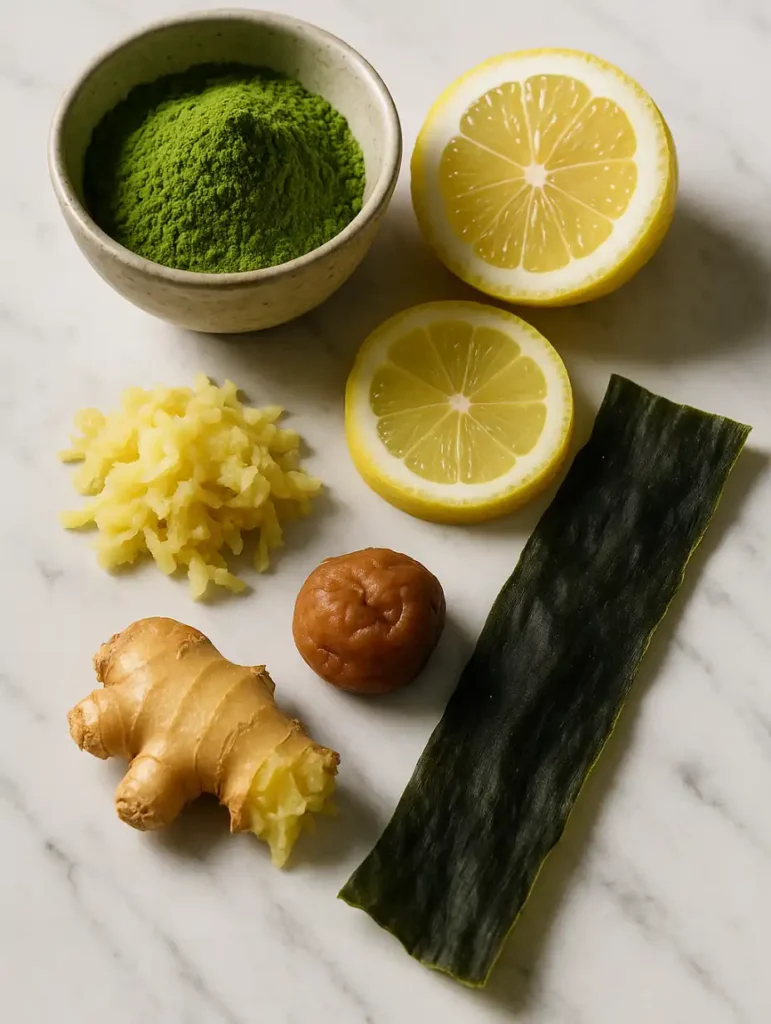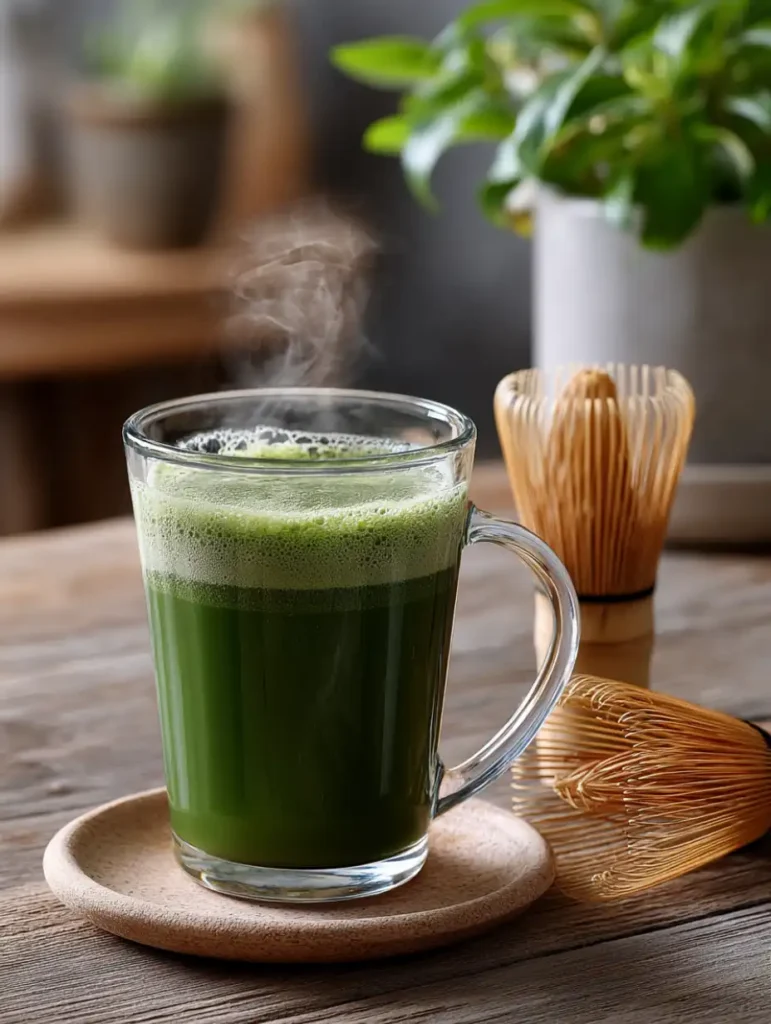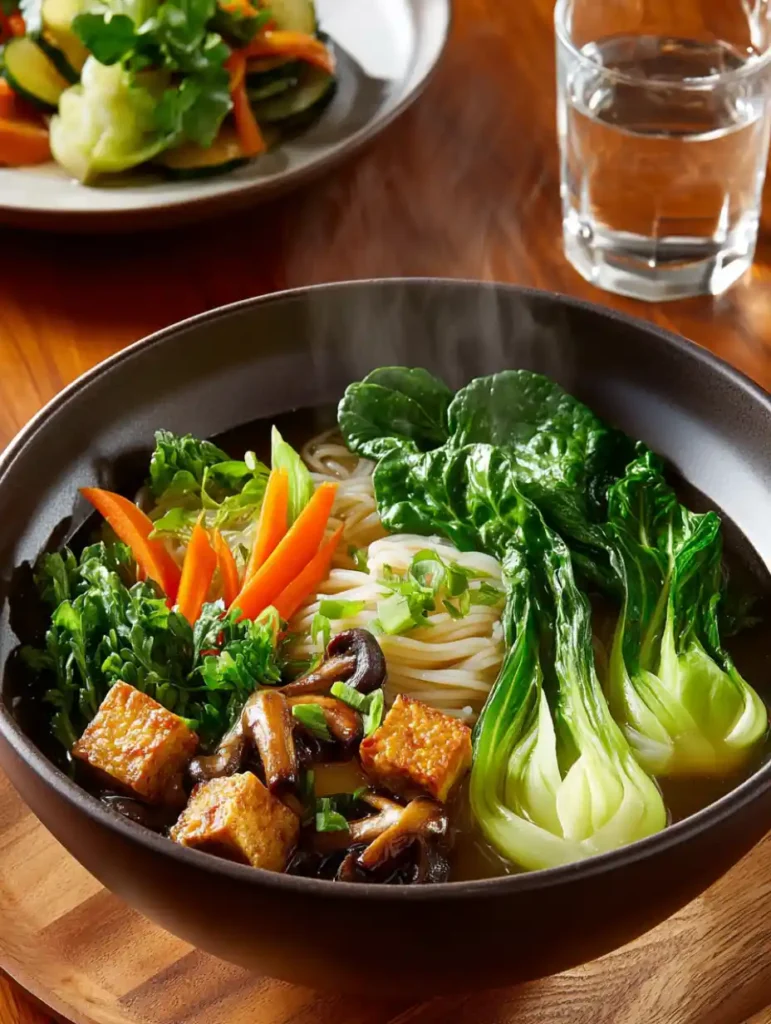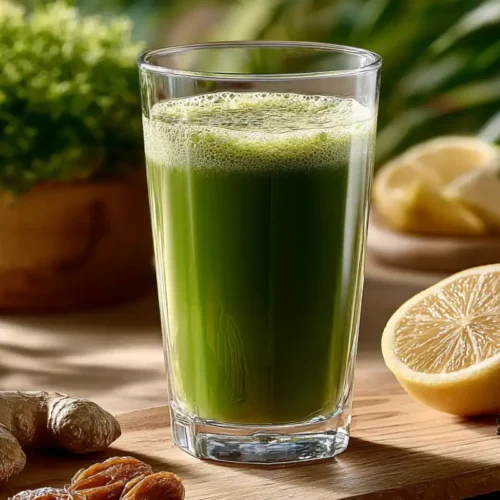Looking for the so-called Japanese Mounjaro recipe that’s trending online? Let’s get one thing straight from the start: this is a food-based recipe, not the prescription drug Mounjaro (tirzepatide). The two share a name in internet chatter, but that’s where the similarity ends. What we’re talking about here is a simple blend of traditional Japanese ingredients: matcha, ginger, kombu, and umeboshi that people enjoy as part of a wellness routine.
Why does it matter? Because anyone searching for weight-loss support deserves clarity. While the medication is an FDA-approved treatment, this recipe is a natural drink rooted in food culture. Think of it less like a pill and more like a morning ritual that can support digestion, metabolism, and overall balance.
To add extra confidence, this guide is reviewed by a registered dietitian. That means you’ll get practical notes on benefits, safety, and who might need to be cautious.
By the end of this article, you’ll know exactly what the Japanese Mounjaro recipe is, how to make it step by step, and whether it fits into your health goals.
What Is The Japanese Mounjaro Recipe
A Food Based Drink, Not The Medication
Online, “Mounjaro” usually refers to tirzepatide, a prescription medicine for type 2 diabetes. The drink in this guide has nothing to do with that drug. For medical details about the injection, see the FDA drug snapshot for Mounjaro. Our recipe is simply a blend of common ingredients used in Japanese kitchens.
Why People Call It Mounjaro
The nickname spread because people shared this drink as a “natural alternative” to the medication. While effects are not comparable to a prescription therapy, fans like its light appetite-curbing feel and digestive support. The name stuck, and now “Japanese Mounjaro” is a search trend on its own.
Roots In Japanese Food Culture
- Matcha has long been part of tea culture and is known for a steady lift.
- Umeboshi (pickled plum) is a salty, sour staple often paired with rice.
- Kombu is a backbone of dashi broth and adds minerals.
- Ginger is used across Asia for a calm stomach.
Ingredient Benefits At A Glance
Matcha And Metabolism
Matcha is rich in catechins, especially EGCG. The NIH notes that green tea catechins combined with caffeine may increase fat oxidation, a normal way the body uses energy (NIH weight loss fact sheet).
Umeboshi And Gut Support
Umeboshi is fermented, which ties it to probiotic foods. Harvard Health points out that fermented foods may help strengthen the gut microbiome (Harvard on fermented foods).
Kombu And Iodine
Kombu is a natural source of iodine. The NIH iodine fact sheet explains that iodine is needed to make thyroid hormones, which support metabolic activity (NIH iodine fact sheet).
Ginger And Digestion
NCCIH reports that ginger may help with certain kinds of nausea, though much research tests supplements rather than foods (NCCIH on ginger).
Light Cautions For Each Ingredient
- Matcha: Contains caffeine; if you’re sensitive, start low. For context, the FDA cites about 400 mg per day as a general upper limit for most adults (FDA on caffeine).
- Umeboshi: High in sodium, which may not suit low-salt diets.
- Kombu: Very rich in iodine; more is not always better.
- Ginger: Large amounts may interact with blood-thinning medicines.
How To Make The Drink
Ingredients

- 1 teaspoon matcha powder
- 1/2 teaspoon grated fresh ginger
- 1 lemon slice with peel
- 1 small piece dried kombu
- 1 umeboshi
- 1 1/2 cups hot water
Yield: 1 serving
Time: about 10 minutes
Step By Step Instructions

- Boil the water, then turn off the heat. Add the kombu and steep 5 minutes.
- Lift out the kombu. Add the grated ginger and the lemon slice. Steep 2 to 3 minutes.
- Whisk in the matcha until it looks smooth and frothy.
- Drop in the umeboshi, stir gently, and sip while warm.
Tips
- Whisk briskly to avoid clumps.
- If the taste feels too strong, add hot water in small amounts.
- If the drink tastes too salty, use a smaller umeboshi or split one plum across two servings.
Nutrition Per Serving
This drink is very low in calories. Most of the energy comes from matcha. Sodium varies based on the umeboshi brand and size, and iodine varies with the kombu piece. If you track numbers closely, log your specific products for the most accurate values.
Make Ahead And Storage
- Brew the kombu and ginger base in advance, then chill it for up to 24 hours.
- Whisk in fresh matcha right before drinking for the best taste and color.
- Add the umeboshi just before serving.
- Reheat gently until warm. Do not boil after adding matcha.
Goal Based Variations
Anti Bloat Blend
Add a few fresh mint leaves to the base. Keep the umeboshi, but use half a plum to reduce sodium while keeping a probiotic edge.
Pre Workout Energizer
Use 2 teaspoons of matcha instead of 1, and add a splash of fresh orange juice in place of the lemon slice. If you prefer a small snack, try our Matcha Chia Pudding.
Caffeine Free Evening Mix
Skip the matcha and replace it with roasted barley tea or roasted rice tea with low caffeine. Keep the ginger for warmth, and let the kombu steep longer for a deeper flavor. For a colorful, no-caffeine option, see our Blue Spirulina Smoothie.
Lower Sodium Option
Watching salt? Swap the umeboshi for a small splash of apple cider vinegar. You’ll still get the sour bite, without the sodium load.
Japanese Mounjaro Bowl For Satiety

The drink is light and refreshing, but sometimes you want something more filling. This Japanese Mounjaro bowl uses similar flavor notes and turns them into a full meal that keeps you satisfied longer.
Ingredients
- 1 package shirataki noodles (rinsed and drained)
- 1 tablespoon miso paste
- 1 cup low sodium vegetable broth
- 1 small piece kombu
- 1 teaspoon grated fresh ginger
- 1 umeboshi (mashed)
- Steamed vegetables of choice (bok choy, spinach, mushrooms, carrots)
- Optional protein: tofu cubes (try our Agedashi Tofu for a crisp option), soft boiled egg, or grilled chicken
Steps
- Warm the vegetable broth in a pot with kombu and ginger; simmer gently for 5 minutes. Remove the kombu.
- Stir in miso paste until dissolved.
- Add shirataki noodles and cook for 2 to 3 minutes to absorb flavor.
- Stir in the mashed umeboshi.
- Top with steamed vegetables and your protein of choice. Serve hot.
Nutrition
This bowl is very low in calories thanks to shirataki noodles. It stays nutrient dense from miso, kombu, and vegetables. Protein boosts satiety, while umeboshi adds probiotics and tang. Sodium varies with miso brand and serving size.
Meal Prep And Storage
- Prepare the broth and noodles ahead of time, then store in the fridge for up to 2 days.
- Keep vegetables and protein separate until serving to preserve texture; pack a simple side like roasted zucchini and carrots.
- Reheat gently on the stove; avoid boiling once miso is added.
Japanese vs Alternatives
Side By Side Table: Japanese vs Brazilian vs Lemon Water
| Feature | Japanese Mounjaro | Brazilian Mounjaro | Lemon Water |
| Main Ingredients | Matcha, kombu, umeboshi, ginger | Pineapple, cucumber, ginger, mint | Lemon juice, water |
| Flavor Profile | Earthy, sour, savory, slightly bitter | Fresh, fruity, lightly sweet | Tart, clean |
| Caffeine | Yes (from matcha) | No | No |
| Minerals | High in iodine (kombu) | Low | Minimal |
| Probiotic Potential | From umeboshi fermentation | None | None |
| Primary Goal | Support digestion, steady energy, gentle appetite control | Hydration, light detox, vitamin C | Hydration, mild reset |
| Who May Avoid | Those sensitive to caffeine, iodine, or sodium | Those sensitive to pineapple | Those with acid sensitivity |
Which One Fits Your Goal
- Japanese Mounjaro: Best if you want a more complex, traditional recipe with both probiotics and metabolism-linked compounds.
- Brazilian Mounjaro: A lighter, refreshing choice if you prefer fruity flavors and no caffeine. Try our Brazilian Mounjaro recipe for the fruit-forward version.
- Lemon Water: A simple, low effort option for hydration and a morning reset.
Is It Safe For You A Dietitian’s Advice
Any recipe that promises support for weight loss deserves a reality check. This one is food-based, so it’s generally safe for most healthy adults, but there are a few things to keep in mind.
Who May Benefit
- People looking for a low-calorie drink to replace sugary beverages
- Those interested in fermented foods for gut health
- Anyone who enjoys matcha and wants a morning ritual with a gentle lift
- People trying simple food swaps for better balance
Who Should Be Cautious
- Pregnant or breastfeeding women: Matcha brings caffeine, and kombu is high in iodine. ACOG advises keeping caffeine under 200 mg per day during pregnancy (ACOG guidance).
- Thyroid conditions: The NIH notes iodine is vital but excess can affect thyroid function, so regular large amounts of kelp are not wise (NIH iodine consumer PDF).
- High blood pressure: Umeboshi is salty and may raise sodium intake.
- Caffeine sensitive: Matcha may cause jitters or sleep issues if taken late.
Medication Timing And Sensitivities
If you take thyroid medicine, timing matters. The NHS advises taking levothyroxine on an empty stomach and separating it from certain foods; soy can reduce absorption, and kelp can be very high in iodine (NHS levothyroxine guidance). When in doubt, check with a health professional before making this a daily habit.
Taste And Troubleshooting
This recipe isn’t your average sweet green tea. Its flavor is bold, tangy, and savory, which surprises many first-time drinkers. Here’s how to make it work for you.
Adjust Sour Salty Bitter
- Too sour? Use half an umeboshi or replace it with a splash of apple cider vinegar.
- Too salty? Rinse the umeboshi before adding, or use a smaller piece.
- Too bitter? Lower the water temperature before whisking in the matcha, around 160 to 170°F.
Swaps If Umeboshi Is Hard To Find
Not everyone has access to pickled plums. Try one of these easy swaps:
- Apple cider vinegar (1 teaspoon)
- Lemon juice with a pinch of sea salt
- Sauerkraut brine (1 teaspoon) for a probiotic touch
If you like tangy fermented drinks, you might also enjoy our Tejuino drink.
Common Mistakes And Quick Fixes
- Matcha clumps: Sift it before whisking or stir it into a little cool water first.
- Overpowering kombu: Do not boil it. Steep in hot water, then remove after 5 minutes.
- Flat taste: Add a slice of citrus or a few mint leaves to brighten the flavor.
Sources And Review Notes
Dietitian Review Note
This article has been reviewed by a registered dietitian to confirm that the recipe and its ingredient notes are accurate and balanced. The advice here is food-based, not medical treatment. If you have ongoing conditions or take medication, check with your health professional before making it a daily habit.
References Used
- Peer-reviewed studies and health agency pages for catechins and caffeine context
- University and agency writeups on fermented foods and gut health
- Government fact sheets on iodine and thyroid function
- Health agency pages on ginger and digestive support

Japanese Mounjaro Recipe for Weight Loss
Equipment
- small pot or kettle
- matcha whisk (chasen) or small whisk
- mug or heatproof cup
Ingredients
Drink
- 1 teaspoon matcha powder
- 1/2 teaspoon fresh ginger, grated
- 1 slice lemon with peel
- 1 small piece dried kombu (kelp)
- 1 umeboshi (pickled plum)
- 1 1/2 cups hot water
Instructions
- Boil the water, then turn off the heat. Add the kombu and steep 5 minutes (do not boil the kombu).
- Lift out the kombu. Add the grated ginger and the lemon slice. Steep 2 to 3 minutes.
- Let the liquid cool slightly (about 160–170°F / 71–77°C). Whisk in the matcha until smooth and frothy.
- Drop in the umeboshi, stir gently, and sip while warm. Adjust with more hot water if the flavor is too strong.
Notes
| Nutrient | Amount | % DV* |
| Calories | 20 kcal | — |
| Carbohydrates | 4 g | 1% |
| Protein | 1 g | 2% |
| Total Fat | 0 g | 0% |
| Saturated Fat | 0 g | 0% |
| Cholesterol | 0 mg | 0% |
| Sodium** | ~520 mg | 23% |
| Potassium | ~140 mg | 3% |
| Fiber | ~1 g | 4% |
| Total Sugars | ~1 g | — |
| Vitamin A | — | ~2% |
| Vitamin C | — | ~8% |
| Calcium | — | ~2% |
| Iron | — | ~4% |
Nutrition
Final Thoughts
The Japanese Mounjaro recipe isn’t magic, but it is a smart, food-based ritual. With matcha for steady energy, kombu for minerals, umeboshi for gut support, and ginger for digestion, it’s an easy way to support your routine without heavy claims.
If you enjoy the drink, try the bowl variation when you want a filling meal. Both versions share the same idea: traditional ingredients used with intention.
Consistency beats intensity here. Add the recipe to your morning or evening routine and see how it feels for your body. Pair it with balanced meals, enough rest, and regular movement, and it can become a small but steady part of a healthy lifestyle.
FAQ
1. What is the Japanese secret drink for weight loss?
It’s a simple blend of matcha, kombu, umeboshi, ginger, hot water, and a lemon slice. People online call it the Japanese Mounjaro recipe. It is a food recipe, not the medication.
2. What are the ingredients in the Japanese Mounjaro?
Matcha powder, grated fresh ginger, a lemon slice, a small piece of kombu, one umeboshi, and hot water.
3. How do you make the Japanese Mounjaro at home?
Steep kombu in hot water, add ginger and lemon, whisk in matcha until smooth, then drop in the umeboshi and stir. Sip warm.
4. What is the difference between the Mounjaro recipe and the Mounjaro drug?
The recipe is a drink made from food ingredients. The drug Mounjaro is a prescription injection for type 2 diabetes and weight management, described by the FDA.
5. How long might it take to notice any benefits?
Digestive comfort can feel immediate for some people. Weight-related changes take longer and depend on diet, sleep, and activity. Treat this as a supportive habit, not a quick fix.
6. Is it safe during pregnancy or thyroid conditions?
Use care. ACOG suggests keeping caffeine below 200 mg per day in pregnancy, and NIH highlights getting enough but not too much iodine if seaweed is a regular ingredient. If you have thyroid issues or are pregnant, ask a health professional first.










Thank you rebecca